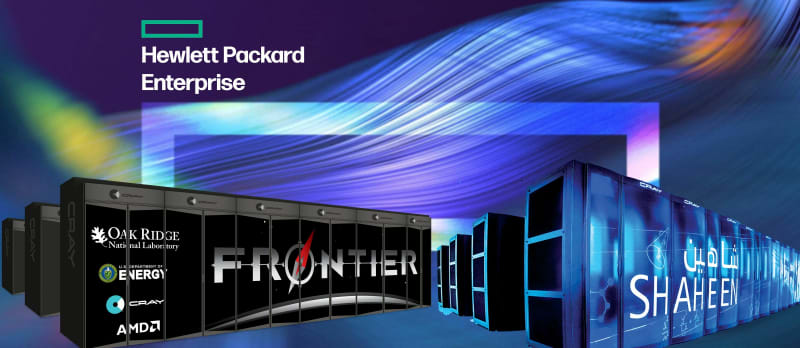In the world of high-performance computing (HPC), there is a continuous quest for pushing the boundaries of what's possible. The pursuit of faster, more powerful, and efficient supercomputers has been a driving force behind ground-breaking research and technological advancements. In this spirit, Hewlett Packard Enterprise (HPE) has once again cemented its position as a leader in the HPC space with the introduction of the HPE Cray Supercomputer, shattering records and opening new frontiers in computational capabilities.
The Era of Exascale Computing
The HPE Cray Supercomputer represents a monumental milestone in the field of high-performance computing, heralding the era of exascale computing. Exascale is defined as one quintillion (10^18 i.e., a billion-billion) floating point calculations per second. For purposes of scale, it would take 40,000 years for one quintillion gallons of water to spill over Niagara Falls. This extraordinary level of processing power allows scientists, researchers, and engineers to tackle complex challenges that were once deemed insurmountable.
One of the most remarkable feats of the HPE Cray Supercomputer is its ability to crunch massive datasets at unprecedented speeds. It enables scientists to simulate intricate systems, such as climate models, astrophysical phenomena, molecular interactions, and nuclear fusion, with exceptional precision and detail. The computational muscle of the HPE Cray opens up new possibilities for breakthroughs in various scientific disciplines, from climate science to drug discovery.
Architectural Marvels
At the heart of the HPE Cray Supercomputer lies the revolutionary Slingshot interconnect, designed by Cray, which facilitates ultra-fast data transfer rates and minimizes latency. This high-speed interconnect is pivotal in unleashing the full potential of the supercomputer, enabling thousands of nodes to communicate seamlessly, thereby amplifying the parallel processing capabilities.
Moreover, the supercomputer's architecture has been meticulously designed to optimize power efficiency. The HPE Cray Supercomputer is built using next-generation processors, and the incorporation of liquid cooling technology ensures that it operates at peak performance while consuming minimal energy. This focus on energy efficiency is not only cost-effective but also reflects HPE's commitment to sustainable and eco-friendly technology.
Revolutionizing Scientific Research
The HPE Cray Supercomputer has already begun to revolutionize scientific research across various domains. Astrophysicists are using the supercomputer's capabilities to model complex cosmological events and gravitational interactions, providing new insights into the nature of the universe. Climate scientists can now run highly detailed climate models at regional scales, improving our understanding of climate change and its potential impacts.
In the realm of medicine, the HPE Cray is accelerating drug discovery by simulating the interactions between potential drug candidates and target molecules. This process expedites the identification of promising compounds, leading to more efficient drug development pipelines and, ultimately, better treatments for various diseases.
Dominating the Field - HPE Cray World's No 1 Supercomputer Unveiled
The 61st edition of the TOP500 shows the Frontier system to remain the only true exascale machine with an HPL score of 1.194 Exaflop/s.
The Frontier system at the Oak Ridge National Laboratory, Tennessee, USA remains the No. 1 system on the TOP500 and is still the only system reported with an HPL performance exceeding one Exaflop/s. Frontier brought the pole position back to the USA one year ago on the June 2022 listing with an HPL score of 1.194 Exaflop/s.
HPE holds a dominant position in the Top 500 Supercomputers list, with an impressive presence of 100 Supercomputers in total out of 500.
Notably, three of HPE's CRAY Supercomputers have secured prestigious positions within the top 10 ranks.
|
Rank |
System |
Cores |
Rmax (PFlop/s) |
Rpeak (PFlop/s) |
Power (kW) |
|
1 |
8,699,904 |
1,194.00 |
1,679.82 |
22,703 |
|
|
3 |
LUMI - HPE Cray EX235a, AMD Optimized 3rd Generation EPYC 64C 2GHz, AMD Instinct MI250X, Slingshot-11, HPE |
2,220,288 |
309.10 |
428.70 |
6,016 |
|
8 |
Perlmutter - HPE Cray EX235n, AMD EPYC 7763 64C 2.45GHz, NVIDIA A100 SXM4 40 GB, Slingshot-10, HPE |
761,856 |
70.87 |
93.75 |
2,589 |
HPE Cray Supercomputers in Saudi Arabia (KSA)
|
Rank in KSA |
World Rank |
System |
Cores |
Rmax (PFlop/s) |
Rpeak (PFlop/s) |
|
1 |
23 |
Dammam-7 - Cray CS-Storm, Xeon Gold 6248 20C 2.5GHz, NVIDIA Tesla V100 SXM2, InfiniBand HDR 100, HPE |
672,520 |
22.40 |
55.42 |
|
2 |
33 |
Ghawar-1 - HPE Cray EX, AMD EPYC 7702 64C 2GHz, Slingshot-10, HPE |
714,240 |
19.26 |
22.86 |
|
3 |
113 |
Shaheen II - Cray XC40, Xeon E5-2698v3 16C 2.3GHz, Aries interconnect, HPE |
196,608 |
5.54 |
7.24 |
|
4 |
188 |
Unizah-II - Cray CS500, Xeon Gold 6248 20C 2.5GHz, 10G Ethernet, HPE |
85,560 |
3.49 |
6.84 |
* HPE has been selected to construct Shaheen III, an HPE Cray Supercomputer, for King Abdullah University of Science and Technology (KAUST).
Shaheen III is expected to deliver performance gains that are approximately 20 times greater than its predecessor, Shaheen II
Shaheen III will be the most powerful supercomputer in the Middle East and will be fully operational in 2023/2024
Conclusion
The HPE Cray Supercomputer represents a pivotal moment in the history of high-performance computing. Its record-breaking performance, revolutionary architecture, and energy-efficient design are propelling scientific research to new heights, driving innovation, and addressing some of the most pressing challenges facing humanity today.
Author "Muhammad Bilal"




Top comments (0)